Author: Sword of Damocles

Table of Contents:
Information:
- Release year: 2024
- Country of origin: USA
- Price: $999 / 1100-1150 € (launch price $899)
- Type: open, over-ear
- Dynamic 50 mm drivers: liquid crystal polymer (LCP) membrane, N52 magnets and Atrium Damping System (ADS)
- Impedance: 80 Ohm
- Sensitivity: 103 dB/mW
- Weight: 480 ± 30 g (tested unit 517 g)
- Connection type: 2x 3,5 mm
- Cable: length 1.8 m / connector 4-pin-XLR, 4.4 mm or 6.35 mm
- Accessories: carrying case, cable bag, cleaning cloth, plastic rings for easy attachment of ear pads, cable clips and wooden owner's card
- Lifetime driver warranty for the first owner
Origin of the test unit: self-purchased product
ZMF typically releases both an open and a closed version of most of its headphone models, so it's no big surprise that this also happened for the Bokeh model: closed Bokeh released in 2023 (our review) was joined at the end of 2024 by open Bokeh Open. I don't actually need new ZMF headphones for my already extensive collection, but something about Bokeh Open attracted me, especially in terms of its appearance. Therefore, I ended up ordering it at the launch price of 900 USD, or about 1050 euros including the Finnish VAT. Normally, the headphones cost 1000 USD, which still makes them 100 USD cheaper than the closed variant, and simultaneously ZMF's most affordable product.
ZMF hand-makes its headphones to order near Chicago, so one always has to wait at least a couple of months for them to arrive. This time, the waiting period for me was about 10 weeks. However, during 2025, the manufacturer aims to reduce the manufacturing time for its so-called stock headphones (with fewer customizations) to 1–3 weeks. Impatient individuals can also check the selection of European resellers, from whom certain ZMF models are already quite readily available directly from stock. At the time of writing this article, Bokeh Open is also available as a special version with a different look.
Packaging and accessories
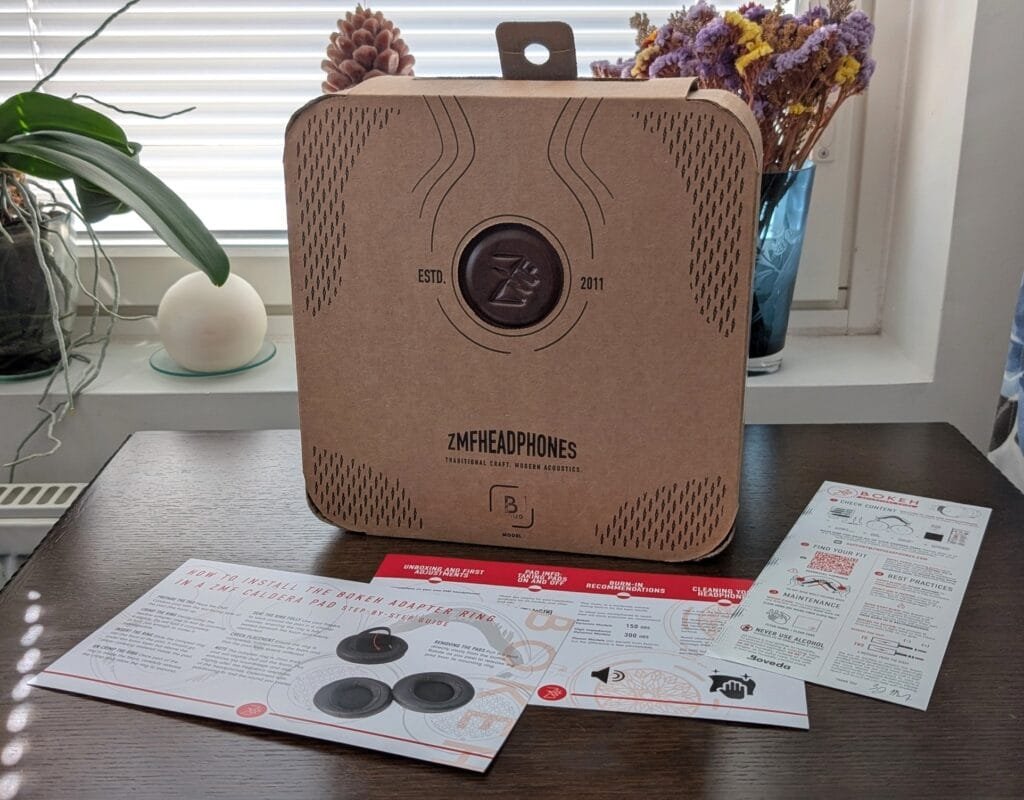
The transport case designed for the Bokeh models is now included directly in the sales price, and it protects the headphones during shipping. In addition to this, a cardboard cover is placed around the case, which hides various instructions and tips inside.

Although the first opening of the case revealed the headphones' appearance to be magnificent, the positive first impression turned into a slight disappointment this time. One of the earpads had detached either during packaging or transport, and the other one was barely hanging onto the headphones. The headphones also smelled strongly of smoke. What the heck, ZMF?
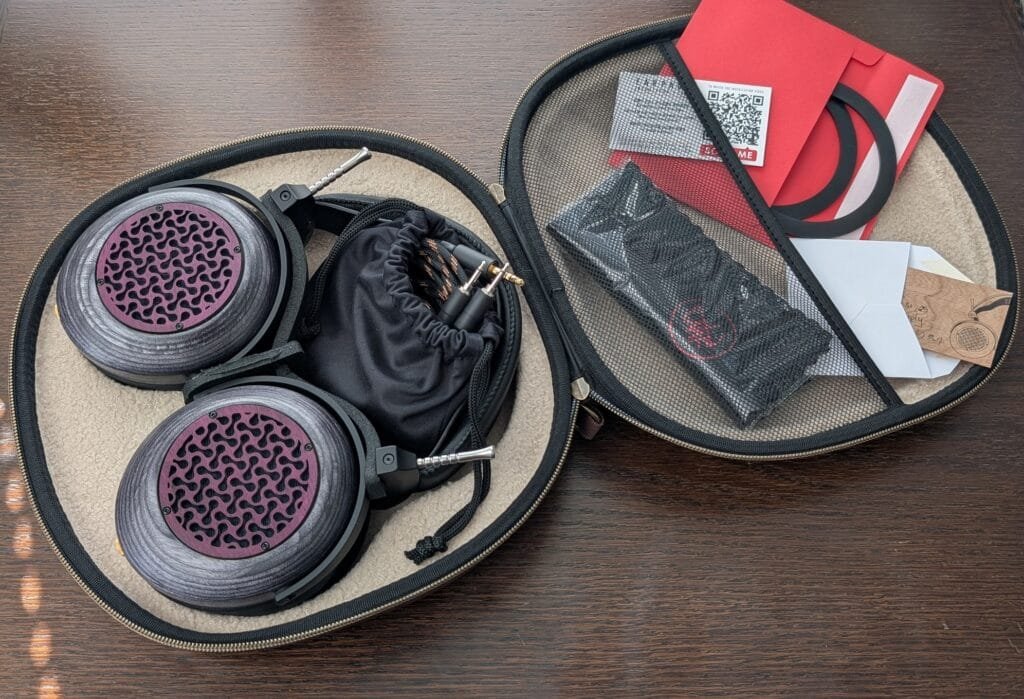
Attaching the earpads is natural for a ZMF veteran like myself, but with Bokeh Open being the manufacturer's most affordable headphone model, it can be expected to find its way into the shopping cart of new customers as well. In this case, hardly anyone expects having to attach the earpads themself, and even if it's not necessarily a difficult operation, the first impression may be poor nonetheless. ZMF has luckily said that it is looking into the matter. The smoke aroma, in turn, was due to laser-cut wooden grilles, from which the smell had not had time to dissipate because the transition from the production line to shipping was exceptionally rapid. Fortunately, the smell did dissipate in just over 24 hours, but it nevertheless had time to spread into the room air and, during the first testing, also to my hair. For those sensitive to smell, the surprise would therefore have been quite unpleasant and, above all, unexpected.
In addition to the headphones and transport case, the package includes a manufacturer's typical braided cable (length 1.8 m), whose connector is selectable at the purchase stage. I myself opted for a 4.4 millimeter balanced option, whereby the cable's fabric sleeve is a slightly more interesting colour instead of black. I'm not quite sure why that particular cable differs in appearance from others, but in any case, it attaches to the headphones with two 3.5 millimeter connectors. This makes the Bokeh models slightly easier to use compared to the mini-XLR connectors on other ZMF models. Additionally, the same cables fit these headphones as, for example, Hifimans. However, I don't really see much need for acquiring a better cable, as the ZMF standard cable is practical.


As a new type of accessory, the buyer receives plastic rings (they arrive in an envelope, so use is optional), which, when installed inside the earpads, should make it easier to attach them to the headphones. The rings sort of widen the edge of the pad, making it easier to stretch it around the wooden driver baffle. I myself, however, attach the earpads to ZMF headphones differently, so it's done about twice as fast without these rings. Many others, on the other hand, have received the accessory well, so I consider it a sensible move from the manufacturer, given how difficult it was to stretch the earpads onto the closed Bokeh version.
Build and comfort

I like purple, so the Nocturne version of Bokeh Open is perfect for me. As a second colour option at the time of release, the reddish Emberstone version would have been available. In both, the grilles on the cups, resembling small bones, are made of wood for the first time, unlike other ZMF models. The material for the cups, in turn, is interestingly coloured plywood, which might initially sound like a cheap material unless one knew it was SpectraPly-branded premium plywood. ZMF could probably buy ordinary wood cheaper, so a certain kind of look has been intentionally sought for Bokeh Open. In the Nocturne version, the cups are grey and their grilles are purpleheart wood. Behind the grilles, a dark blue fabric has also been installed to add a little more contrast to the overall look. The manufacturer generally seems to be more experimental with Bokeh Open than before, as several different versions of the grille patterning have already been seen.

Otherwise, the headphones are structurally similar to the closed Bokeh version. The headband is thus slimmer and more modern compared to more expensive ZMF models. The cups also no longer rotate 360 degrees, but stop at about 180 degrees, for example, when placing them horizontally on a table. Nowadays, the sheepskin parts of the headband can be swapped for suede fabric, similar to the earpads, so Bokeh Open is also suitable for those who want to avoid using animal-derived products. This has indeed always been the case with the manufacturer, but at the time of the closed Bokeh's release, the suede option was still missing being in the works.
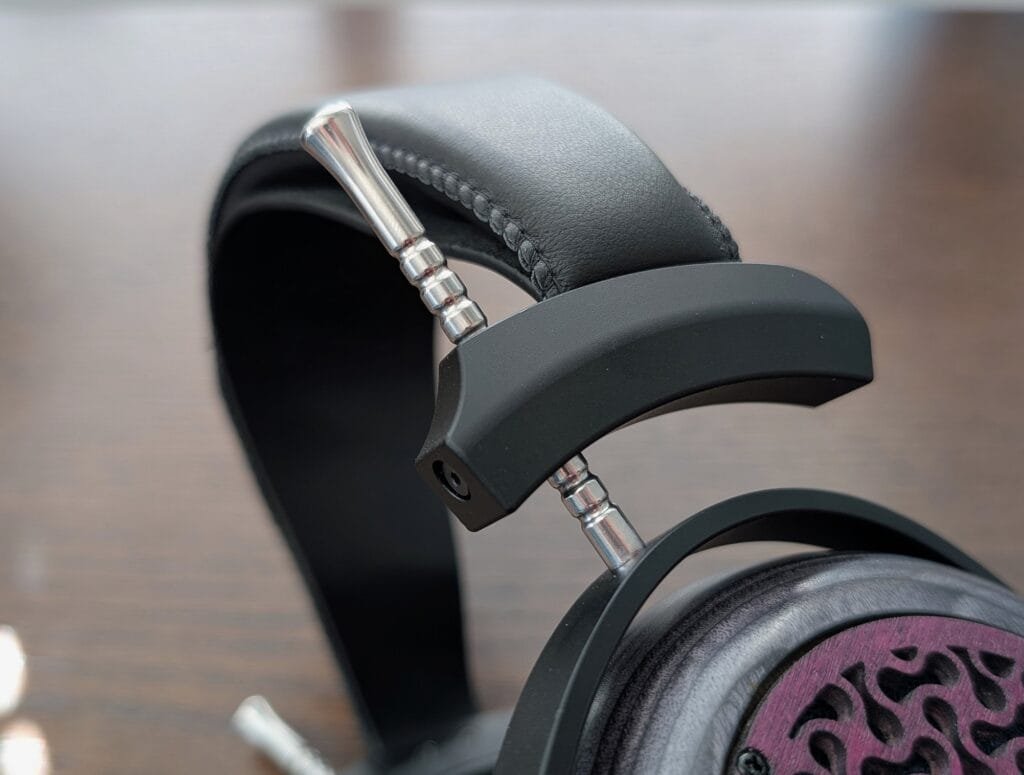

Bokeh Open weighs about half a kilo, so it is by no means light, but also not annoyingly heavy. Thanks to the well-padded headband and shaped earpads, the headphones sit on my head like a nice piece of headwear, whose presence is hardly noticed, but which also doesn't fall off when shaking my head. The renewed structure is currently used only in ZMF's most affordable headphone models, but in my opinion, it surpasses the more expensive models in terms of perceived quality. The headband looks, for example, more modern than before, and the ends of the headband's leather cover no longer fray or hang loose and unfinished.

ZMF, in its traditional manner, offers several different earpad options for Bokeh Open, with which both wearing comfort and sound quality can be fine-tuned. The default earpads this time are of the hybrid type, meaning they are partly covered with leather and suede fabric. Additionally, in front of the driver, there is a partially perforated titanium mesh, which limits the amount of treble. This mesh can be swapped for a solid variant or removed entirely. In fact, the plastic rings I mentioned earlier, which possibly help with earpad attachment, also affect the frequency response, so the possibilities for modifying the sound are even more versatile than before. I myself this time chose not to buy the $120 tuning kit, because ZMF has made the default choices more carefully than for the closed Bokeh. On the other hand, I already owned solid titanium meshes, which I finally ended up using more permanently instead of the perforated meshes.
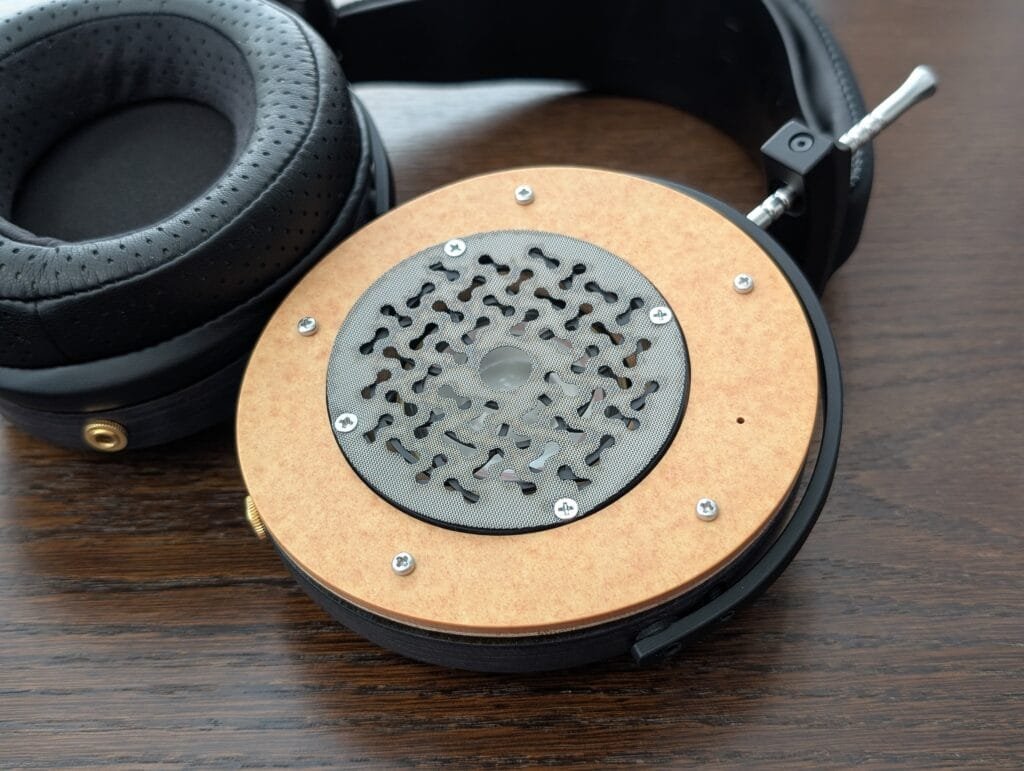
Sound quality
Bokeh Open uses the same 50 mm Liquid Crystal Polymer (LCP) drivers also found in the closed headphone model. An Atrium Damping System (ADS) is installed behind the drivers. This is, simply put, a foam material optimised for the specific driver type and cup construction.

Impedance measurements and amping requirements
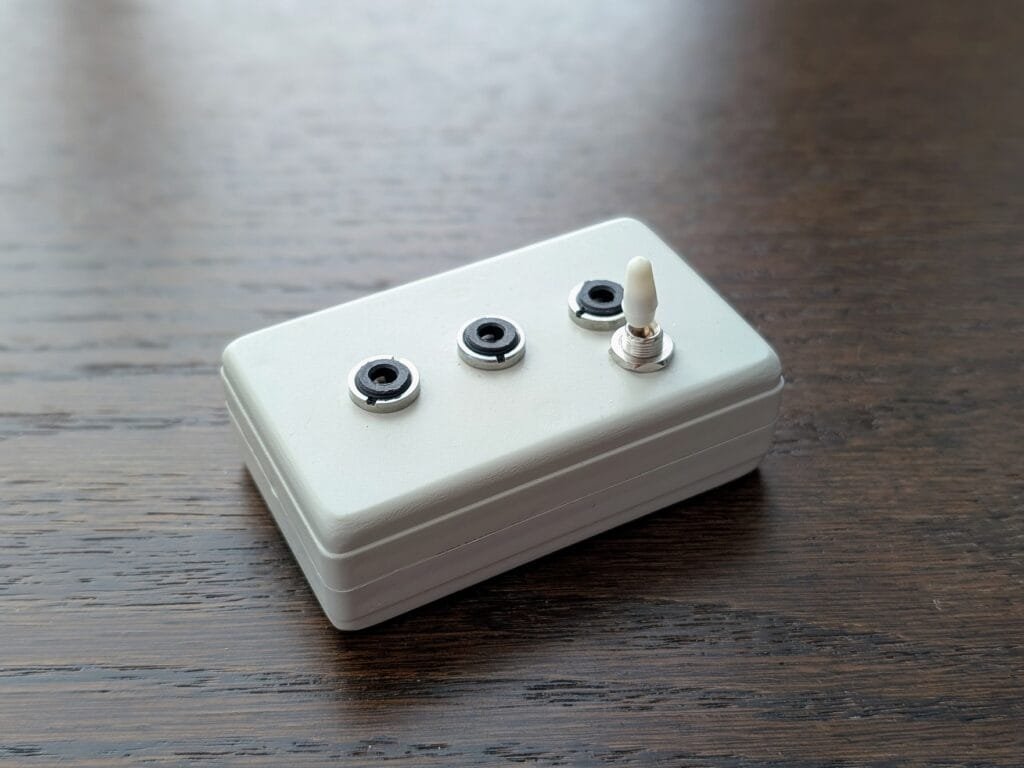

ZMF claims a nominal impedance of 80 ohms for Bokeh Open, but in reality, the impedance curve is somewhat peculiar in its irregularities. Typically for dynamic drivers, the impedance rises slightly upwards at bass frequencies – in this case to just over 100 ohms. A similar rise also occurs around 2 kHz. Fortunately, these impedance peaks do not have a significant effect on the sound, even if the headphones were used with an amplifier having high output impedance. The 120 ohm output impedance I tested boosted the bass and the 2.3 kHz region by only 0.75 decibels compared to an output impedance of less than 1 ohm. The damping factor of the drivers did weaken, however, so the sound changed slightly tonally in any case. Due to their fairly high sensitivity (103 dB/mW), Bokeh Open's drivers are relatively easily driven even by low-power mobile devices, which ZMF seems indeed to have aimed for.
Headphone Measurements
Our frequency response measurements have been made with a clone IEC-60318-4 coupler and KB501X pinnae. The Harman target curve from 2018 is used as a reference point and generalization of the headphone response that would sound good to most people. For more information on the measurements and their accuracy, see Headphone Measurements. All the measurements including Bokeh Open can be found and compared on Squiglink avulla.
Hybrid pads and Vented Mesh (default configuration):
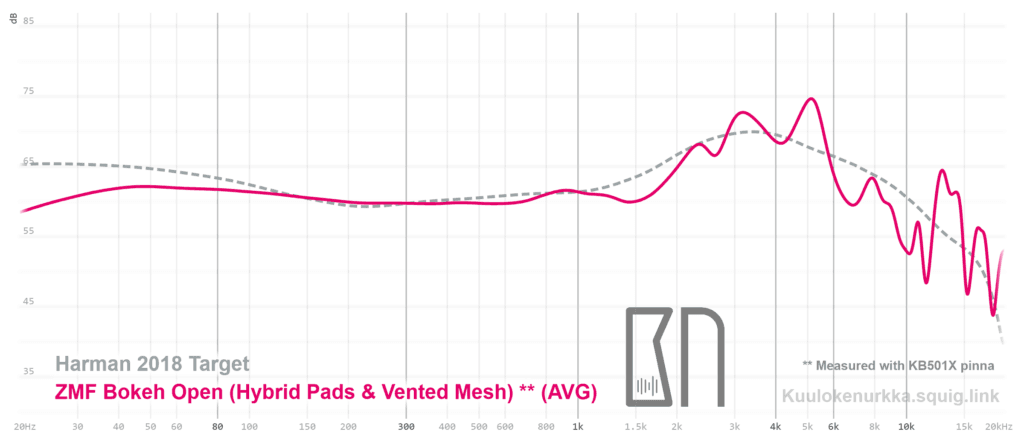
Plastic rings installed inside the pads:

Hybrid pads and Solid Mesh (+plastic rings=my favourite):

Note: the solid mesh I used is the old Bopp Mesh from 2020, but the titanium meshes made today have a very similar effect on the upper frequencies, while being more practical in terms of material.
Sound observations
By my standards, Bokeh Open is ZMF's most neutral and, due to a few treble peaks, also the brightest headphone. The presentation does not, like many other ZMF models, lean on the warmth of the low frequencies and a fatigue-free listening experience, but rather offers quite linear sound spiced with treble energy. This reminds me of Meze Audio 109 Proand 105 AER (tested for AVplus magazine), although Bokeh Open's bass sounds more controlled, so I wouldn't actually call it V-shaped like the Meze models. However, similarities can be found in the recess around 1.5 kHz and in the slightly splashy treble.
Provided the peripherals are not selected according to the same presentation style, Bokeh Open sounds energetic in a fun way. The prominent boosts between 3–6 kHz and near 13 kHz succeed in creating the impression that instruments are played enthusiastically. The presentation always has a lively touch. For example, the drum hits have plenty of force, and cymbals sound airy. At the same time, there is enough bass to add depth to the sound, so I perceive Bokeh Open dynamic above all. All sorts of smaller details also pop out effortlessly from the music.
Despite its emphasized treble, Bokeh Open fortunately does not cross the line where the brightness would start to annoy me; instead, the headphones succeed in finding an interesting balance between brashness and smoothness. Excessive sharpness is thus absent. In my opinion, this is affected by the fact that the upper half of 10 kHz is not emphasized yet at 11–12 kHz, but a little later, around 13–14 kHz. However, if someone doesn't like forward treble or is sensitive to it, Bokeh Open can sound somewhat fatiguing. I myself also keep the volume quite moderate, for which this tuning is better suited than for loud listening. The sound also occasionally has emphasized sibilance in the form of hissing. The characterful upper frequencies are indeed both an important part of the headphones' appeal and at the same time also my biggest single complaint.

In other frequency ranges, Bokeh Open is tuned to be so neutral that there's not much to talk about, except that the ZMF headphones usually have a bit more full-bodied lower midrange. Thus, Bokeh Open is not really a warm-sounding headphone, especially since the emphasized upper frequencies rather make vocal performances sound a bit thin, for example. However, there is still plenty of presence in the vocals thanks to the energetic presence region.
Like many modern headphones, the 1.5 kHz region is played in a subdued manner, but not as recessed as in many Hifiman headphones, for example. To my taste, this characteristic brings just the right amount of spaciousness to the Bokeh Open's soundstage without softening the instruments too much. As a whole, however, it must be noted that the mid-frequencies remain slightly distant, instead of attention being drawn to the lower half of the sound spectrum. In other words, the upper frequencies and sharper sounds stand out more.
The bass isn't very robust, but it sounds fast and punchy, and thus engaging. Usually, an energetic presence region also supports bass reproduction, which is also the case with the Bokeh Open. The lively treble and tight bass fit well together. By adding the plastic adapter rings inside the earpads, the level of the low frequencies can interestingly be raised by 1.5 decibels, whereby subbass rises to almost the level of the Harman curve. After this, sound immediately becomes more full-bodied, although at the same time even brighter in the treble region. I myself consider the result too bright and V-shaped, but with a little equalization, I could make it work.
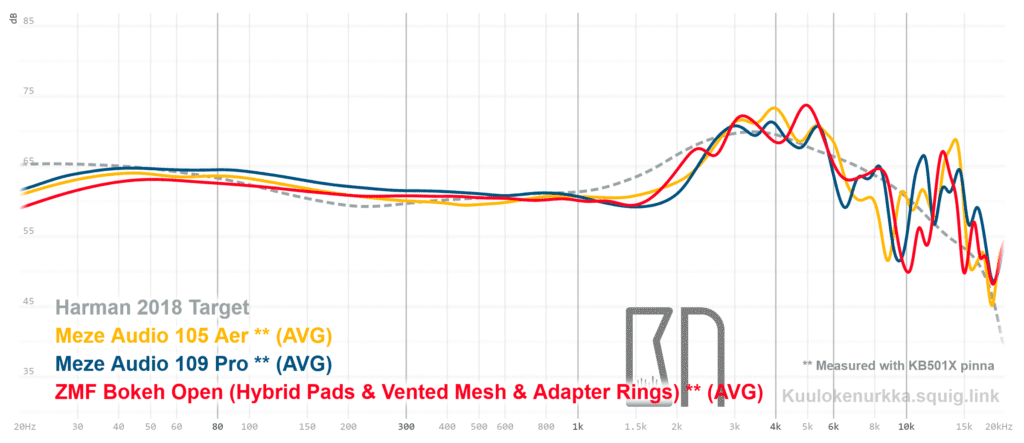
I experience Bokeh Open's soundstage such that the sound doesn't seem to originate inside the headphones, but rather plays as if in empty space, where I can direct my gaze. The depth effect is indeed successful, and I pay more attention forward than to the side edges of the soundstage. Every instrument and musical element plays precisely in its own location. Bokeh Open has the ability to captivate, for which, in my opinion, ZMF must generally be given credit. They tune colored headphones, but in each of them there is a certain kind of working idea, provided expectations do not include completely neutral sound. The closed Bokeh model sounds completely different with its substantial low frequencies and relaxed upper frequencies. Its upper mids are also reproduced more softly and more relaxed than with the open model. Thus, in my opinion, the duo hardly resembles each other, even though the drivers are the same. Superiority is also largely a matter of taste, although I myself do favor the open model.
More balanced sound with solid mesh option
Bokeh Open's treble-emphasized sound has its own charm, but I myself finally ended up changing the partially perforated front damping meshes to the solid option. In this way, I got rid of the considerable treble emphasis in the presence region, whereby the sound became even more neutral. The effect is, of course, entirely subjective. Although I myself am not usually bothered much by the prominence at 5–6 kHz, Bokeh Open's upper frequencies sometimes attract an unnaturally large amount of attention. With the solid meshes, however, this no longer happens.
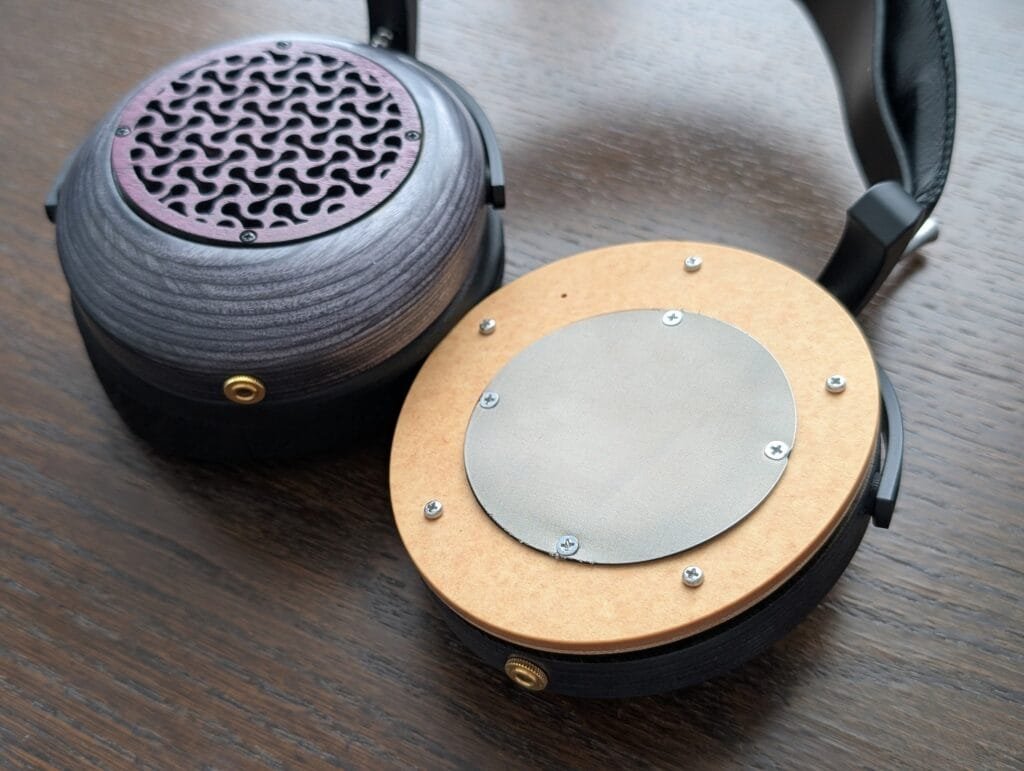
As an unfortunate side effect of the modification, treble is also attenuated between 6-10 kHz, which is not really necessary. Some would probably find the upper frequencies now too quiet, which is why I understand ZMF's decision to choose partially perforated mesh as the default option. However, when plastic rings are inserted inside the earpads, the treble again becomes brighter and more balanced. Considering the simultaneous boost in the low frequencies provided by the rings, Bokeh Open sounds very pleasant. There is more warmth now, and I no longer notice any major accentuation or attenuation in the treble.
Different earpads would offer even more tuning options, but with the configuration I have chosen, the sound quality change is already very successful. In this way, I consider Bokeh Open an excellent headphone because I get ZMF's great looks combined with balanced sound suitable for all kinds of music. The headphones would even feel like a quite straightforward upgrade option for Sennheiser HD 600known for its neutral sound.
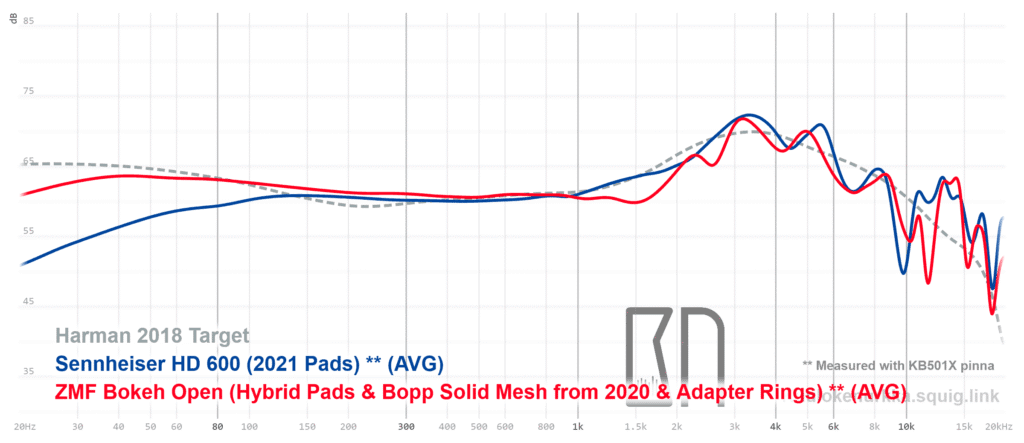
The suitable peripheral choices
Bokeh Open, with its bright treble, sounds to me most appropriate with amplifiers that make the upper frequencies a bit more relaxed and lower frequencies more full-bodied. For example, Cayin HA-3A-tube amplifier shifts attention slightly away from the treble and towards the midrange. Also Ferrum Audio OOR balances the presentation compared to neutral devices, although it still doesn't eliminate the treble emphasis of the headphones. Where other ZMFs, such as the Aeolus or Atrium may sound too warm with the same warm-leaning amplifiers, Bokeh Open still offers a fairly neutral experience. As such, I think it's well suited for tube amps, which is also supported by the 80-100 ohm impedance.
With solid meshes, Bokeh Open can be listened to with more versatility, using almost any amplifier, because the treble no longer requires the same amount of balancing. For example, I've liked the Topping Centaurus & Gold Note HP-10 -combination, which makes the soundstage pleasantly realistic and well separated. At the other extreme, Fiio's small Snowsky Retro Nano (priced around 65 €) drives the ZMF headphones very well with its balanced jack. Despite its low price, the Retro Nano also includes a parametric equalizer like the one found in Qudelix 5K.
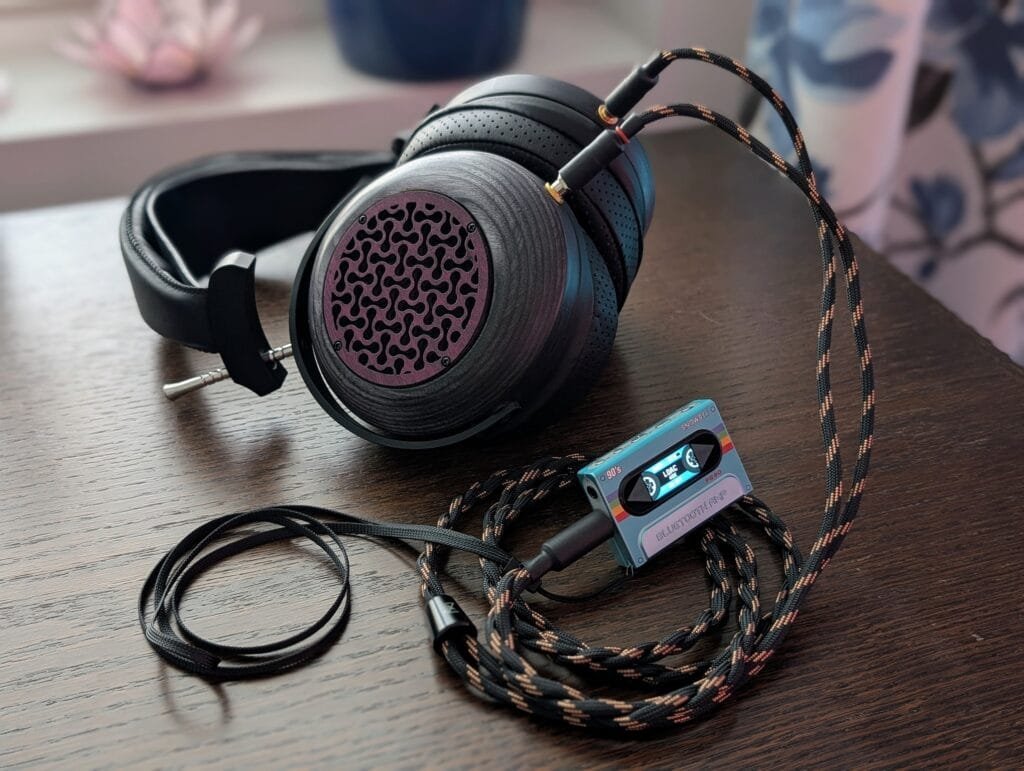
Comparison: ZMF Bokeh Open vs. Focal Hadenys
Prices: 1100-1150 € (depending on the exchange rate) vs 700 €

Sleek and light Focal Hadenys is, in my opinion, a great all-rounder for 700 euros. It has bass, clarity as well as easy-going treble. Some may find the narrow headband a little hard, but on my head Hadenys fits comfortably. It also doesn't require much amplification, so it's easy to use.
ZMF's Bokeh Open weighs over 200 grams more and is also larger. In terms of its intended use, however, it slightly resembles the Focal model because the need for amplification is likewise low, and the appearance is also slimmer than the rest of the ZMF lineup. The package even includes a transport case, like Hadenys, so maybe one could even travel with Bokeh Open? In terms of comfort, Bokeh Open is quite comparable, if not even slightly better thanks to its well padded headband. For many, the 400 euro price difference compared to Hadenys could also be justifiable by the wooden parts, the craftsmanship, and the versatile customizability.
Although Hadenys is indeed more easily driven of the two due to its lower impedance of under 30 ohms, I consider Bokeh Open's 80 ohm impedance more practical in home conditions. The headphones can be driven with different amplifiers without background noise pushing through as easily. Hadenys is so sensitive that it is recommended to listen to it with devices that measure well, or alternatively with amplifiers having moderate power rating and gain factor.
Differences in sound quality in favour of ZMF
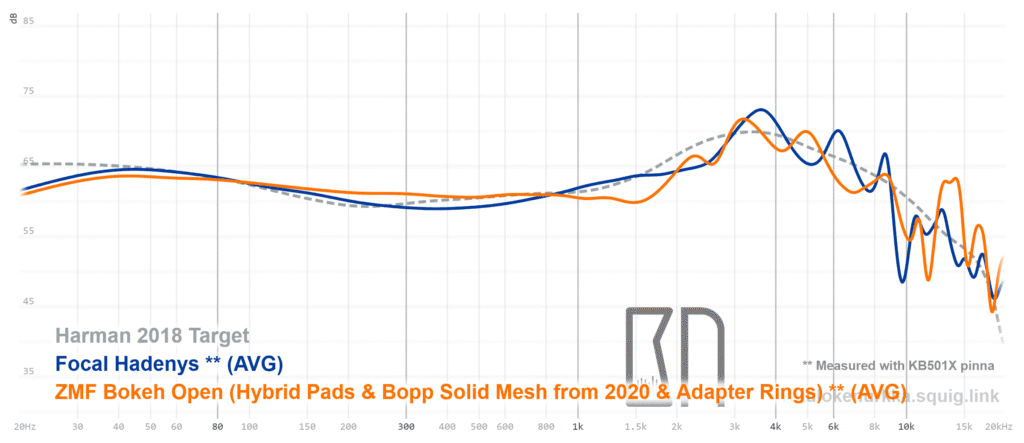
With its default settings, the Bokeh Open sounds more neutral in the bass and brighter in the treble than the Focal Hadenys. Therefore, I found the comparison more sensible by considering my own fine-tuned configuration with the ZMF model. The Bokeh Open's sound is designed to be inherently tunable, so it only made sense to do so. For the comparison, I used my preferred tuning: solid meshes installed in front of the drivers and plastic adapter rings placed inside the earpads.
After that, these two headphones differ most significantly in the energy level of the mid-range. The Bokeh plays the 1-2 kHz range more smoothly, so the vocals are rendered further back in the soundstage, and the presentation is otherwise more spacious compared to Hadenys, while also being more relaxed. Hadenys draws my attention to the closer-sounding vocals and the overall crispness of the sound. At the same time, it reproduces the lower mids more lightly, so the presentation is a bit thinner compared to Bokeh Open, and on the other hand, also slightly coarser in the lower treble. Hadenys is indeed the clearer and more energetic sounding of the two, whereas Bokeh Open without its default treble peaks sounds warmer and has a slightly more relatable timbre – Focal's new headphones bring the 3-4 kHz range forward a touch aggressively.
In my opinion, Bokeh Open has improved soundstage compared to Hadenys, as the ZMF model literally sounds like a larger headphone. The sound has more depth, and the presentation generally opens up more impressively around me. It is easier to pinpoint things 'happening' within the soundstage, whereas Hadenys largely places sound in my head, while luckily avoiding the 'three-blob' soundstage sometimes associated with the Sennheiser HD 600 series. The difference is likely due to tuning differences, but partly also to the Bokeh's larger earpads.
Both headphones reproduce subbass excellently for an open-back design, with no significant difference in quality. Bokeh Open's more linear reproduction of the 200-600 Hz range makes the sound slightly more robust, giving instruments a heftier body and adding more warmth to the vocals. Hadenys, in turn, keeps the bass and midrange more separate. The presentation is a tad thinner and less pleasant to my taste, but the trait has a positive effect on clarity. Hadenys also creates a greater contrast between lows and highs and plays subbass a tad more effortlessly, so the Harman-style 200-300 Hz dip undoubtedly has its advantages.
After my fine-tuning, Bokeh Open plays the treble slightly smoother than even Hadenys, which I consider fatigue-free. At the same time, the ZMF model's sound is more airy, which likely contributes positively to the openness of the soundstage. Hadenys, in turn, sounds more lively between 6-8 kHz, which is also sometimes beneficial, especially as the sound is never overly sharp.
In summary, I like both headphones, slightly favoring Bokeh Open – at least in my preferred tuning. The ZMF model's soundstage is more engaging, and the midrange timbre is slightly more natural compared to Hadenys. I also like the airiness of Bokeh Open's treble, because Hadenys can sound a tad dark, which further emphasizes its smaller soundstage. Taking taste into account, I wouldn't necessarily say the sound quality improvement alone is worth the 400 euro difference, but Bokeh Open justifies its higher price by other means as well. Hadenys, in turn, can sometimes be found for 500 euros during sales, making it a more sensible purchase for most people. Since the Focal model also has slightly clearer and more energetic mids, I would argue it's a better and safer all-around headphone for those who don't quite know their headphone preferences yet. Thanks to modern tuning, both headphones are still suitable for a wide range of music genres.
Summary
In my opinion, Bokeh Open is a successful headphone release from ZMF. Whereas the manufacturer's other models sound more or less warm and relaxed, Bokeh Open is more neutral and more assertive in the treble – a welcome change, if not even a departure from the previous lineup. I also consider the price of about 1100 euros suitable, especially when the headphones look and feel as high-quality as more expensive ZMFs. The comfort is great, and the buyer also gets a comprehensive accessories and tuning options. Since the treble sounds somewhat wild to my taste by default, the tuning options were actually genuinely beneficial.
As such, I dare not recommend Bokeh Open to listeners who dislike bright treble, as the frequency response may require slight adjustments. Otherwise, I don't have any major complaints, as my slightly negative unboxing experience could very well have been just bad luck. Good headphones can be bought even cheaper, but Bokeh Open is something to be proud of even compared to more expensive products. In the end, it doesn't cost a fortune by today's standards. I'd even say the headphones are so successful that many other ZMF models now seem a little overpriced. On the other hand, this is a positive sign that the manufacturer is not deliberately making its cheaper models inferior. The Bokeh Open will eventually make it to my wall of fame, where it will replace ZMF's more expensive Auteur models in its price range.
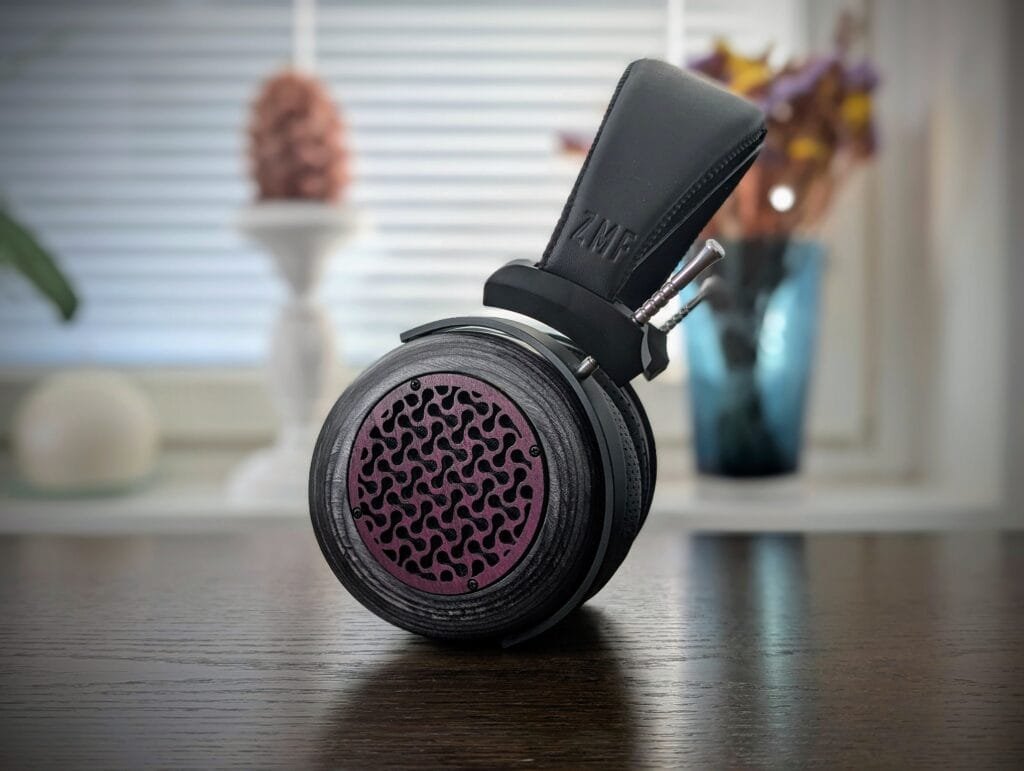
Pros and cons:
+ More neutral sound compared to other ZMF models
+ Energetic and clear presentation
+ Versatile tuning options
+ Good comfort
+ Great looks and high quality construction
+ Does not need a powerful amplifier, but is suitable for e.g. tube gear
+ Comprehensive accessories
+ Lifetime driver warranty
-/+ Changing ear pads is still a challenge, but the supplied adapter rings may make it easier
- Treble may be too much for some by default
- The headphones arrived with one earpad detached
- Strong smell of smoke when opening the package